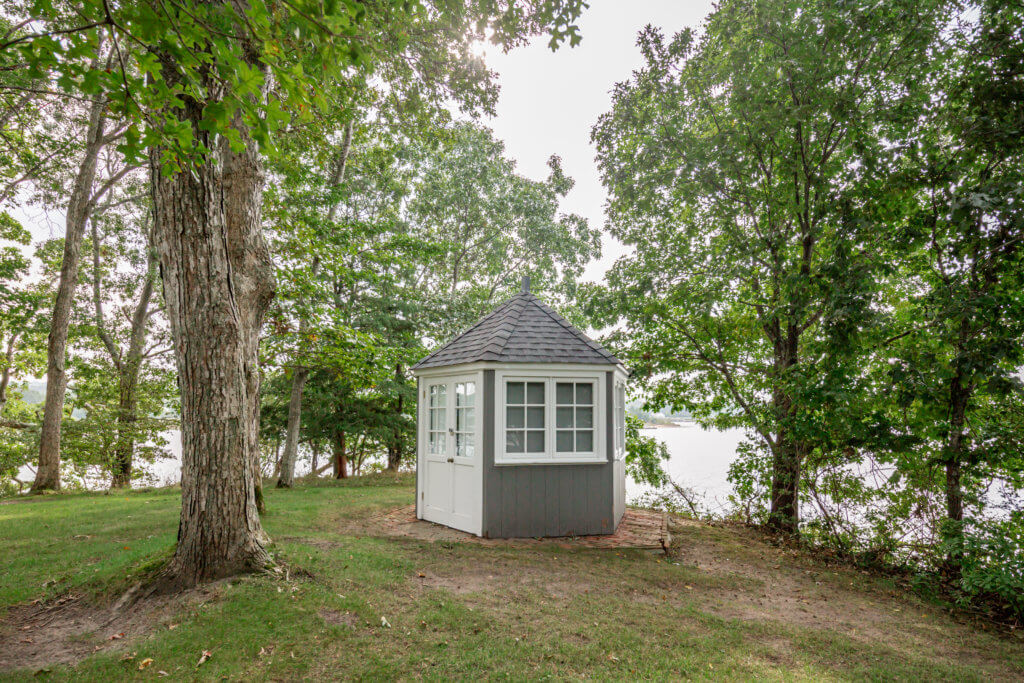Southampton Town Board Approves $11.2M for John Steinbeck's Sag Harbor Property

Kathryn Szoka, an owner of Canio’s Books in Sag Harbor, handed each Southampton Town Board member a pencil following their unanimous decision to spend $11.2 million to purchase the development rights on the waterfront property that John Steinbeck once called home.
It was Szoka who first raised the idea that the Nobel laureate’s modest home and his unique gazebo-like writing studio at 2 Bluff Point Lane, on a 1.8-acre peninsula overlooking Morris Cove and Upper Sag Harbor Cove, should be preserved when it first came on the market in February 2021. Listed at $17.9 million, any public purchase seemed like a long shot.
“Every once in a while we get to do something historic. I believe this is historic,” said Supervisor Jay Schneiderman just before the vote, following a public hearing Tuesday and a marathon-long meeting that lasted nearly five hours.
Steinbeck and his wife, Elaine, bought the property with the house on it in 1953. He had an octagonal, glass writer’s gazebo built overlooking the water, and it is where he wrote The Winter of Our Discontent, his last novel, published in 1961. He called the cottage, Joyous Gard, after Lancelot’s castle, and, as Szoka told the board, he wrote with a pencil on a yellow pad.
Despite having won the Pulitzer Prize for fiction for The Grapes of Wrath in 1940 and then later the Nobel Prize for literature in 1962, he enjoyed relative anonymity in Sag Harbor. He was known to walk around in a fisherman’s cap and rubber boots with his dog, Charley, in tow, even when he went to local dives like the Black Buoy.
In Sag Harbor, like much of the East End, “We kind of didn’t care in a way, which made a lot of folks who had national prominence be individuals in this community,” said Councilman Tommy John Schiavoni, who spearheaded the town’s part in this project. “As the grandson of an Italian grocery store owner in Sag Harbor, I will be voting yes on this.”
It took a lot of work to get to this point, he said, as he thanked the Sag Harbor Partnership, which is in contract to purchase the property, and the Michener Center for Writers at the University of Texas in Austin, which will lease the property and develop the Steinbeck Writers’ Retreat, a residency program.
The Sag Harbor Partnership, a nonprofit organization that rebuilt the Sag Harbor Cinema, agreed to purchase the property for $13.5 million.
Southampton Town will contribute $11.2 million from the Community Preservation Fund, money that is raised by a 2% tax on most real estate transactions. While the property is in the Village of Sag Harbor, money on all transactions goes to the town the village is located.
Meanwhile, the Partnership has to fund the remaining $2.3 million, a significant portion of which has already been raised through private donations and a $750,000 state grant.
At the town’s public hearing Tuesday, Susan Mead, the co-president, reported to the town board that the organization has about $199,000 left to go.
A fund-raising effort has begun on GoFundMe.com to close the gap. Donations of $1,000 or more will allow a donor to have their name on a brick, and donations of $2,500 or more will earn a spot on a plaque honoring supporters. Donations are tax-deductible.
The University of Texas has committed a $10 million endowment to protect, manage and run the writer’s program, according to Mead.
Tuesday was the second public hearing on whether the town should use the CPF money for development rights. The sticking point during the one held late month was the public access plan for the property.
An agreement has since been reached between the town board, the Partnership and the Michener Center.

The access plan, available on the town’s CPF website, calls for open houses on Memorial Day, Labor Day and Columbus Day weekends. The public would be able to go inside the house by appointment only from 10 a.m. to 4 p.m., with 20 slots available per hour, including 10 people who could arrive in a single boat. Only the bedrooms would be off-limits since the writers are staying in the house.
On Saturdays in June and July, visits would be by appointment only, with the same 20 slots available from noon to 4 p.m. The main house would not be open, but visitors could walk the grounds and view the gazebo.
From the fall through the spring, the public could visit on Saturdays, by appointment only, from noon to 4 p.m., with a maximum of 20 visits per hour.
Jacqueline Fenlon, the town’s acting CPF manager, said parking has also been a balancing act. “We don’t want to degrade the quiet neighborhood and create a large parking slot,” she told the board. Seven parking spots have been identified, five of which will be for the public and there will be compliance with the Americans with Disabilities Act.
The writers in residence will also hold a writing class one day per year that will be open to two high school students from each school in Southampton Town.
Councilman Tommy John Schiavoni, who spearheaded the town’s involvement, also pointed out that the property will also be given a historic designation.
While the community response has been overwhelmingly favorable during the hearing, the public access plan was not without dissenters.

David Nelson told the board it was insufficient. “It is a plan to have a plan at some point in the future,” he said of the document. “It doesn’t have the detail necessary to support an $11 million purchase.”
Parking, traffic, toilets, logistics, legal issues and other intricate matters should be more clearly defined, he said, “before you write a check, especially one over $11 million.”
“There is no reason to rush — the property has been on the market for years and the real estate market is cold.”
Nelson also raised a question about who really benefits from the town’s expenditure; the estate of Elaine Steinbeck and the Univesity of Texas, which he said has a $43 billion endowment.
“I wonder why Southampton will put 83% of the funds, which will only buy the development rights for a sliver,” he said. “One board seat out of 15.”
“Another reason not to rush is there are better alternatives,” he continued. “The CPF could use the money to buy the 7-Eleven property to double the size of Steinbeck Waterfront Park,” he said of the commercial property in the village that recently came on the market for $25 million after the Friends of Bay Street abandoned a plan to create a new theater there.
“The writing gazebo,” which he said is the only valuable structure on the property, “could be moved there making it accessible to hundreds of times more people with a far greater community benefit.”
Schneiderman later commented that using CPF money towards the preservation of this property does not preclude the board from using it for another property. The town is fortunate to have “ample funds.”
“It’s not a competition,” he said. “We’re looking at a lot of different things in the Sag Harbor area.”
Councilwoman Cyndi McNamara was the last to sign on as a co-sponsor of the resolution to spend the money.
“I really had a hard time with the access plan on this,” she said, explaining she wanted to see public access with no appointment necessary. “I think there is a real hope of having that happen.”
She recently paid a visit to the site with her 17-year-old daughter who perked up by having to go on a work-related visit with her mother when she saw Steinbeck’s gazebo.
“Taking that gazebo and sticking it in the park and not having the experience of that — it would be a tragedy,” she said referring to Nelson’s earlier comment.
“That park comment today put me over that this needs to be preserved and seen,” she concluded. “It’s just ironic that somebody in opposition put me over the edge.”
Email tvecsey@danspapers.com with further comments, questions or tips. Follow Behind The Hedges on Twitter, Instagram and Facebook.




